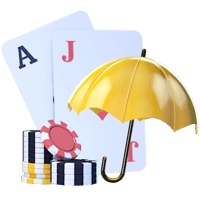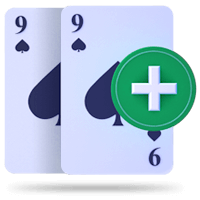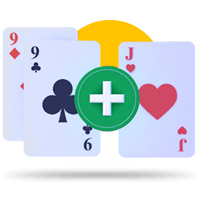Blackjack Odds, House Edge & Payouts
Blackjack is one of the few casino games where you can significantly influence the house edge through your decision-making.
By understanding blackjack odds, house edge, and payout structures, you can make informed decisions that minimize losses and maximize your chances of winning.
In this guide, I’ll explain how these elements interconnect and provide tips to help you become a more skilled player.
By learning how probability affects your decisions and how different rules and payouts impact the house edge, you can improve your overall blackjack strategy.
Basic Concepts About Blackjack Probability and Odds
Learning odds is more than memorizing a bunch of numbers or learning a strategy. If you want to properly understand them, you must know the base concepts relevant to all forms of gambling.
These concepts will help you apply odds to common gambling scenarios and help you become a better blackjack player.
Probability
Probability is the chance of something happening. For example, the probability of being dealt a natural blackjack (an Ace and a 10-value card) in a single-deck game is 8 out of 663 possible combinations, or about 1.2%.
Odds
This is the percentage of successful bets compared against unsuccessful bets. For example, the odds of winning a hand of blackjack is 42.22%, meaning that all other results are not a win.
Another example is the odds of drawing an Ace from a 52-card deck, which can be expressed as 4 to 48, or simplified to 1 to 12.
Payouts
Payouts are the amount of money you win on a bet. For example, a 2:1 payout means you win two dollars for every one dollar you bet. In blackjack, a standard payout for a natural blackjack is 3:2, meaning you win $3 for every $2 you bet.
House Edge
The house edge is the casino’s advantage over the players. In blackjack, the house edge is usually around 0.5% when using basic strategy.
This means the casino expects to win about 50 cents for every $100 bet by players. If the house edge is 1%, the casino expects to win $1 for every $100 bet.
RTP
RTP is the percentage of money that a blackjack game will return to players over time. If a blackjack game has a 99% RTP, it means that for every $100 bet, players can expect to get back $99 in the long run.
This theoretical percentage shows how much of the total money bet will be returned to players over many games.
If you are new to gambling, I recommend reading our blackjack terms guide for a comprehensive list of the terms used in this article.
Key Takeaways
- Understanding the probability of different outcomes helps you grasp the odds, which in turn informs your strategic decisions.
- The main difference between probability and odds is that probability shows the chance of something happening, while odds compare the chance of it happening to the chance of it not happening. For example, if you have a 16 in blackjack, the probability of busting (going over 21) on the next card is 62%.
This probability can be converted into odds: if you think of 100 draws, about 62 will result in a bust and 38 will not. Simplified, this ratio is roughly 62 to 38, which can be approximated to about 5 to 3.
This means that for every 8 times you draw a card, about 5 times you will bust and 3 times you won’t. - The house edge directly affects the RTP. A lower house edge means a higher RTP, which is better for players. So if a game has a house edge of 2%, the RTP would be 98%. House edge considers winning percentages from the casino’s perspective, while RTP considers winning percentages from the player’s perspective.
- Payouts influence the house edge. Favorable payouts (like 3:2 for a blackjack) reduce the house edge, while less favorable payouts (like 6:5) increase it.
Blackjack House Edge
As I mentioned, the house edge is the amount of money a casino is expected to win from each player.
In standard blackjack games, the house edge can vary significantly based on how you play. Without a strategy, the house edge can be as high as 8%.
However, if you play with a perfect strategy, you can reduce it to as low as 0.2% to 0.6%.
The higher the house edge, the lower the odds of winning for a player. Let’s dive into what can increase or decrease the house edge in blackjack.
What Increases the House Edge?
Several things can increase the house edge of blackjack games. Some involve the configuration of the game, while others involve game rules.
Here are some of the most common ways that a casino can increase the house edge of games.
Adding Decks
The more decks used in a game, the higher the house edge
For example, an eight-deck game has a 0.61% higher house edge than a single-deck game because it becomes harder for players to predict and keep track of cards, increasing the casino’s advantage.
Hitting on Soft 17
If a dealer is required to hit on a Soft 17 (an Ace and a 6), the house edge increases by 0.21% compared to games where the dealer stands on Soft 17.
This is because the dealer has a better chance of improving their hand, which benefits the casino.
6:5 Blackjack Tables
Games that pay 6:5 have a higher house edge by about 1.3% compared to 3:2 games because they give you less money for a natural blackjack, regardless of the bet amount.
For example, instead of winning $15 on a $10 bet, you win only $12.
Splitting Only on 10 or 11
Some blackjack games only allow you to split hands when you have a total of 10 or 11.
This rule increases the house edge by 0.18% because it limits your ability to split other pairs, reducing your chances to improve your hand.
No Doubling Down After Splitting
In some games, you cannot double down after splitting a hand.
This increases the house edge by 0.14% because it prevents you from doubling your bet when you have a strong hand after splitting, such as splitting a pair of 8s and then getting a 2 or 3.
No Splitting Aces
If a game does not allow you to split aces, the house edge increases by 0.07%.
This rule disadvantages players because splitting aces allows you to start two hands with a strong card (an Ace), which increases your chances of making high-value hands like 21 or close to 21.
Can You Reduce the House Edge?
Yes, but it requires action on your part. The first thing to do is to memorize basic blackjack strategy.
When you play with a basic strategy, you can reduce the house edge to as little as 0.5%. However, you must play with perfect strategy on every hand; otherwise, you will not get the full advantage of the house edge.
Next, ensure you avoid side bets, as they have a massive house edge ranging from 3% up to 25%. Insurance bets are also considered side bets and can have a house edge of up to 7.5%.
Lastly, make sure you are playing the right tables. When you use perfect basic strategy, a table paying 3:2 has a house edge of around 0.5%. However, regardless of the strategy used, a 6:5 table has a 2% house edge.
Important note: While reducing the house edge improves your chances, it doesn’t guarantee consistent wins. Variance, strategy errors, bankroll management, psychological factors, and specific casino rules all play a role in your overall success.
In a single $100 bet, you could win, lose the entire $100, or lose any amount in between, depending on the game’s results. The house edge is a long-term expectation and becomes accurate over many bets, not individual instances. Please gamble responsibly.
Blackjack House Edge Vs Other Casino Games
When played with proper strategy, blackjack generally has a lower house edge than all other games at the casino. When you play with a 3:2 payout scheme and perfect strategy, it has the lowest house edge of all table games.
Here’s a quick chart breaking down of how blackjack compares to other casino games. Please note that these refer to most standard games. Some online blackjack variants offer an even lower house edge.
| Game | House Edge |
|---|---|
| Blackjack – 3:2 Payouts | 0.5% – 1.5% |
| Blackjack – 6:5 Payouts | 2% – 3% |
| Baccarat | 1.1% – 14.4% |
| Craps | 1.4% – 16.7% |
| Keno (1-15 Spots) | 25% – 30% |
| Video Keno | 8% – 15% |
| Slots | 1% up to 12% |
| American Roulette | 5.3% |
| European Roulette | 2.7% |
| Video Poker | 0.5% – 5% |
Odds of Winning Blackjack
Before playing your first hand, understand that the house edge always gives the advantage to the dealer. The player’s odds of winning a hand of blackjack are 42.22%, while the dealer has a 49.1% chance to win.
The remaining 8.48% of hands will be a tie, also known as a push. These odds are based on a standard round and do not account for strategy or alternative pay structures, such as 6:5 payouts.
In the following sections, you’ll learn more about the probability of busting out and the odds of getting specific hands in a game.
Probability of Busting
If you want to improve your odds of winning, you need to start by understanding the probability of busting a hand. The charts below break down the probabilities of the player and dealer busting based on what they are holding or showing.
Player’s Hand Busting
This table will help you understand the likelihood of busting when hitting with various hands.
You can use this in conjunction with the dealer’s table to help decide whether to hit or let the dealer take the chance.
Please note that when you make a 21, that is considered an automatic win, or a push if the dealer also has 21. You are not allowed to hit on a 21.
| Hand Value | Probability The Player Busts |
|---|---|
| 11 or Lower | 0% |
| 12 | 31% |
| 13 | 39% |
| 14 | 56% |
| 15 | 58% |
| 16 | 62% |
| 17 | 69% |
| 18 | 77% |
| 19 | 85% |
| 20 | 92% |
| 21 | NA |
Dealer Busting
This table is helpful as it can help you make better decisions based on the dealer’s up-card. The probability of the dealer busting will differ from the player’s probability for multiple reasons.
First, the dealer’s odds are based on their upcard. Next, dealers have strict game rules they must adhere to. Lastly, the dealer acts after the player and can see the player’s result.
| Dealer’s Card | Stand On Soft 17 | Hit on Soft 17 |
|---|---|---|
| Ace | 17% | 20% |
| 2 | 35% | 36% |
| 3 | 37% | 38% |
| 4 | 40% | 40% |
| 5 | 42% | 42% |
| 6 | 42% | 44% |
| 7 | 26% | 26% |
| 8 | 24% | 24% |
| 9 | 23% | 23% |
| 10 | 23% | 23% |
How to Use These Tables?
There are many ways you can use these tables to make better decisions at the table. Let’s take a look at a few scenarios.
Scenario 1 – J-6 for 16
You’re dealt J-6 for 16. The dealer has a six showing and must hit on a soft 17. If you hit, you will have a 62% chance to bust, while the dealer has a 44% chance to bust.
In this scenario, you should stand and let the dealer take the chance at busting since your chance of busting is much higher.
Scenario 2 – 10-3 for 13
You are dealt 10-3 for 13, and the dealer has a 10 showing. Your odds of busting are just 39%, while the dealer’s odds are even lower.
In this scenario, you will want to hit and improve your hand, as it is likely that the dealer will be able to draw multiple cards.
Scenario 3 – 10-8 for an 18
You’re dealt 10-8 for an 18, but your dealer is showing an Ace and can stand on a soft 17. You don’t take insurance.
The dealer has the lowest possible odds of busting. However, you have a 77% likelihood of busting. This is a straightforward case of standing and hoping the dealer is unlucky.
Scenario 4 – 9-6 for 15
You are dealt a 9-6 for 15. The dealer is showing a 5 and can hit on a Soft 17.
Based on the straight probabilities alone, the smartest play is to stand and let the dealer take the risk.
Remember that the above scenarios involve playing the game normally without strategy considerations. There are times when smart play may not align with probability charts. However, until you master perfect basic strategy, these charts will give you an edge over the average player.
Dealer Hand Probabilities
We have discussed the likelihood of busting, but let’s talk briefly about dealer hand probabilities. Since the dealer has set rules they must follow, we know the range of hands they will play.
Here’s a rundown of the probability of a dealer finishing with each hand.
| Dealer Final Hand | Probability % |
|---|---|
| Blackjack | 4.82% |
| 21 (3 or more cards) | 7.36% |
| 20 | 17.58% |
| 19 | 13.48% |
| 18 | 13.81% |
| 17 | 14.58% |
In short, the dealer will only bust 28.37% of the time. The other 71.63% of the time, he will make a hand of 21 or under.
Knowing these figures will give you a more realistic outlook on the types of hands the dealer can hold rather than always assuming they will have the best possible hand.
Blackjack Payouts
The payout structure is important because it directly influences the house edge and the overall odds of winning.
The better the payout structure, the lower the overall house edge, assuming you’re playing with proper strategy and avoiding side bets. By picking favorable payout structures, you put yourself in the best position to win the game.
3:2 Payout
This is the traditional payout structure, paying 3 to 2, or 1.5x your bet on a blackjack hand.
For example, if you bet $10, a blackjack will pay $25. The house edge in this game is between 0.5% and 1.5%.
6:5 Payout
This structure is becoming more popular at casinos as it has a higher house edge.
A blackjack pays 6 to 5, or 1.2x your bet. For example, if you bet $10 and hit Blackjack, you get $22. The house edge is between 2% and 3% on 6:5 games.
2:1 Payout
In some rare instances, you may find a table paying 2:1 on a blackjack.
In this case, a $10 bet will return $30 on a blackjack. This actually puts the edge slightly in the player’s favor.
Pro tip: Always review the payout table of the game you are playing to know the payout structure it has.
Payouts Table Example
All blackjack games have a paytable that explains how much you can win on each win type.
Below is a standard example for the majority of blackjack games you’ll find both in live and online casinos. We’re including the insurance bet as many tables offer this bet.
| Outcome | Payout | Example Bet | Example Winnings | Total Return |
|---|---|---|---|---|
| Blackjack | 3:2 (1.5x) | $10 | $15 | $25 |
| Standard Win | 1:1 | $10 | $10 | $20 |
| Tie (Push) | Bet Returned | $10 | $0 | $10 |
| Insurance | 2:1 | $10 + $5 | $5 | $10 |
Tips to Get Better Odds and Lower the House Edge
Here are some tips to help you cut into the Blackjack house edge. Follow these guidelines, and you start with a better chance to win.
Always Play with a Hit/Stand Strategy Chart
Find a good Blackjack Strategy Chart, memorize it, and stick to it. It is your best weapon against the house.Only Play Games That Pay 3:2 on Blackjack
Some tables may offer 6:5, but don’t play them. If you run into 2:1, consider yourself lucky.Only Play Games Where the Dealer Hits on Soft 17
They have a house edge of 0.21%. If the dealer can stand on soft 17, the house edge becomes 0.4%.You Don’t Always Need to Improve Your Hand
You can win with a 12 or 13 if the dealer has a lousy up-card and ends up busting. Make the house play those odds.Avoid Side Bets
They often suck you in with high payouts, but they are a long shot to hit for a win.
Comparing the Odds of Different Blackjack Games
The probability of hitting a hand does not change much between blackjack variants. What does change is the house edge of many games based on various factors. Let’s look at the probability of specific hands in blackjack games and how the house edge changes in different blackjack variants.
Classic Blackjack
We’ll start looking at Classic Blackjack, sometimes called American Blackjack. This is your standard variation, and the base probabilities for this game will apply to the other ones.
Other titles may have differing rules, such as how to split hands, but the probability of drawing a hand is the same. Here’s a brief chart on your probability of hitting a hand.
| Hands | Probability |
|---|---|
| 21 | 4.8% |
17-20 | 30% |
1-16 | 38.7% |
No Bust | 26.5% |
Online Blackjack
Online blackjack games mostly have the same hand probabilities as the classic version. The difference in these games comes from variations in rules or the theoretical number of decks used in a game.
I reviewed the games of three different software providers (Betsoft, Dragon Gaming, and Nucleus,) to give you a general idea of how the number of decks affects the house edge.
However, you may encounter games with slightly different numbers, depending on the provider. Here are my findings.
| # of Decks | House Edge |
|---|---|
| 1 | 0.112% – 0.45% |
| 2 | 0.341% – 0.412% |
| 4 | 0.4999% – 0.556% |
| 6 | 0.551% – 0.603% |
| 8 | 0.5577% – 0.627% |
Live Dealer Online Blackjack
Depending on the Live Casino provider, live dealer online blackjack can have a slightly lower house edge. Here is a comparison of the blackjack games from some of the most popular Live Dealer providers for US online casinos.
| Provider | Game | House Edge |
|---|---|---|
| Ezugi | Blackjack | 0.11% |
| Ezugi | Unlimited Blackjack | 0.35% |
| Evolution Gaming | Infinite Blackjack (With Six Card Charlie) | 0.45% |
| Lucky Streak | Blackjack | 0.49% |
| Vivo Gaming | Blackjack | 0.50% |
| Asia Gaming | Blackjack | 0.62% |
| Visionary iGaming | Blackjack / Early Payout Blackjack | 0.69% |
| Evolution Gaming | Live Dealer Blackjack | 0.72% |
Other Popular Land-based Blackjack Versions
Here are some popular blackjack games in land-based casinos. Some of these games can also be found at online casinos.
Free Bet Blackjack
This game is popular because players can split or double down for free.
The catch is that the dealer pushes on 22 rather than busts. The house edge on this game is 1.04%
Blackjack Switch
Blackjack Switch requires you to play two hands at once, and you have the option of switching your two top cards.
The catch for this variant is that blackjack only pays even money, and the dealer pushes on 22. The house edge on this game is around 0.58%
Spanish 21
Spanish 21 has multiple side bets, which are easier to win but pay out less than other games. Also, the 10s are stripped from the deck, taking away 20% of the blackjack hands and making it less likely for the dealer to bust.
This game has around a 2% house edge using strategy and around a 4% house edge for inexperienced players.
Bet the Bust Blackjack
This is a standard blackjack game that lets you make a side bet based on the dealer’s upcard.
You’re betting on whether he will bust. If you’re playing the side bet, the house edge on this game is around 5.478%.
Which Blackjack Version Is the Best?
In theory, the best version is Vegas Strip Blackjack. Due to its splitting and double-down rules, the house edge in this game is just 0.34%. Let’s look at some of the other variants.
Please note that I’m including variants of standard blackjack games with traditional rules.
| Blackjack Variation | House Edge |
|---|---|
| Double Exposure Blackjack | 0.69% |
| Single Deck Blackjack | 0.58% |
| Classic Blackjack | 0.5% |
| Spanish 21 | 0.40% |
| European Blackjack | 0.39% |
| Atlantic City Blackjack | 0.35% |
| Vegas Strip Blackjack | 0.34% |
Are Blackjack’s Side Bets Worth It?
Side bets in Blackjack are oh so tempting and do enhance the fun of a hand. Take a closer look at your chances, though, and you will find that side bets drastically increase the house edge. Here are the most common side bets offered.

Insurance
Insurance is the most common side bet. You’re basically protecting against a dealer Blackjack. However, that happens less than one-third of the time, so the house edge is pretty high at 7.5%.

Perfect Pairs
You get this option online quite a bit. Don’t let those attractive payouts lure you into making a bad decision. The house edge is from 3 – 11% for this bet, depending on the rules and number of decks.

21+3
The huge payouts sound sweet, but it’s a risky option when you consider a house edge of 6% to 8% on the bet. This wager is a long shot. You’re better off sticking to playing the standard game.
My Key Takeaways
Understanding the house edge, odds, and payouts in blackjack is crucial for making informed decisions and improving your chances of success.
While the house edge represents the casino’s long-term advantage, knowing the odds helps you make strategic choices during play. Favorable payout ratios, like 3:2 for a natural blackjack, significantly impact your potential winnings.
By mastering basic strategy and choosing games with player-friendly rules, you can minimize losses and enhance your overall gaming experience. Remember, even with the best strategy, short-term outcomes are influenced by luck, so always gamble responsibly.
